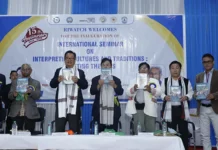[ Wangtum H. Lowang ]
Over the past few years, I have been contemplating whether the tribes, including Nocte, Tangsa, Tutsa and Wancho, who inhabit the Tirap, Changlang and Longding districts of Arunachal Pradesh, might share a common language in the future. Though, this may sound impossible for now, in my honest opinion, I find this idea plausible because I believe that at some point in history, we might have spoken a proto or mother language that was likely the same. However, as we took different migration routes and interacted with diverse neighbouring communities over time, our languages gradually diverged into distinct forms.
English, as we know it today, is a magnificent testament to linguistic evolution. It is a fascinating amalgamation of various languages, borrowing elements from diverse linguistic sources over centuries of cultural exchange and historical interactions. This diverse borrowing from other languages has given English its exceptional richness in vocabulary, making it a global lingua franca and a powerhouse of expression. By embracing the unique elements of various languages and dialects within our community, we can create a language that resonates with all stakeholders, bridging cultural divides and enhancing communication. As we appreciate the beauty of different linguistic traditions, we can cultivate a linguistic ecosystem that fosters mutual understanding and inclusivity.
There is an interesting story called the Tower of Babel, where humans spoke one language and started to build a tower to reach the heavens. God was not pleased about this, and so, he introduced the humans to different languages. After this, the humans were unable to understand each other and ultimately abandoned their work and migrated to different places. While the story is allegorical, it reflects the challenges that arise when people speak different languages and struggle to communicate effectively. Therefore, I believe that we will never be one in spirit as long as we speak different languages, no matter how similar our cultures are.
While my dream will sound inapprehensible to many people, let me tell you that the Mizos achieved something similar years ago. They successfully formed a common language, and surprisingly, they accepted the majority of unique terms from a much smaller dialect. This collaborative effort to craft a common language will require careful consideration, collaboration and willingness from all stakeholders to develop a language that incorporates shared vocabulary and expressions. Additionally, it’s crucial to ensure that the process is inclusive and respectful of the unique identities and cultural nuances of each tribe. We can begin with compiling a list of all common terms in one column and the unique ones in another. The goal would be to reach a consensus on adopting specific unique terms from each tribe, and with dedication, dialogue and open-mindedness, it is indeed possible to establish a common language that can bring our tribes closer together. It can serve as a powerful tool for promoting cohesion, cooperation and harmony among our people.
(The contributor is director of Nocte Digest. Email: Wangtum@live.com)




